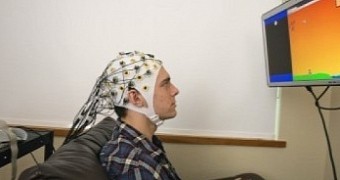A new paper in the journal PLOS ONE details a series of experiments during which researchers made it possible for volunteers to influence other people's behavior by means of a direct brain-to-brain connection.
In a nutshell, here's what these experiments boiled down to: a group of really lucky volunteers got to control the hand movements of others after scientists used state-of-the-art equipment and software to establish a connection between their brains.
To get a better idea of what all the fuss is about, imagine being able to get a person standing not all that close to you to scratch their nose just by thinking about it. Pretty cool, right?
How was the brain-to-brain connection established?
Writing in the journal PLOS ONE, the University of Washington scientists behind the experiments detail that this latest investigation into mind melding was carried out with the help of six volunteers who were split into three pairs.
One of the members of each of the pairs was hooked to an electroencephalography machine that served to keep tabs on their brain activity. The other member had a swim cap fitted with a magnetic stimulation coil put on their head.
When the volunteers connected to the electroencephalography machine thought about moving their hand to fire a cannon as part of a computer game they were asked to play, specific brain signals were picked up and sent to the other volunteers via the Internet.
The magnetic coil fitted on the swim cap worn by the other volunteers reacted to these signals, meaning that it stimulated the brain and triggered hand twitches. Simply put, these other volunteers pressed a touchpad as if to fire a cannon even though they had no intention to do so.
It's important to note that the participants in this study sat in different buildings all throughout this series of experiments. Thus, they were about 0.5 miles (0.8 kilometers) away from each other, and except for the connection between their brains, they had no way to interact.
Not the first experiments of this kind
As surprising as this may sound, these experiments are not the first of their kind. Thus, in February 2013, researchers mind melded two rats. Specifically, they made it possible for one such rodent located in North Carolina to influence the behavior of another one hundreds of miles away, in Brazil.
What's more, it was in August 2013 that the University of Washington specialists behind this latest investigation into brain-to-brain connection first enabled a person to control another one's hand movements. At that time, the brain-to-brain connection was established not between regular folks, but between researchers.
Commenting on the success of these experiments involving volunteers, study co-author Andrea Stocco said, “The new study brings our brain-to-brain interfacing paradigm from an initial demonstration to something that is closer to a deliverable technology. Now we have replicated our methods and know that they can work reliably with walk-in participants.”
There's plenty of work left to do
The University of Washington scientists explain that they wish to continue investigating brain-to-brain connections between people. Interestingly enough, word has it that they now want to focus on trying to transmit more complex information.
Thus, the researchers say that they want to find a way to have people send visual information and psychological phenomena like rules, concepts and thoughts to others without having to actually interact and communicate with them.
They argue that, thanks to their work, it might one day be possible to have a teacher simply transfer their knowledge to their students by establishing a brain-to-brain connection with them. “Imagine someone who's a brilliant scientist but not a brilliant teacher. Complex knowledge is hard to explain – we're limited by language,” said scientist Chantel Prat.

 14 DAY TRIAL //
14 DAY TRIAL //